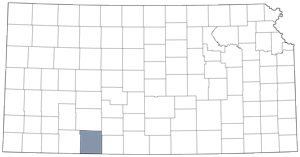Clark State Fishing Lake
Clark State Fishing Lake in north-central Clark County is set in a deep and scenic canyon created by Bluff Creek. A variety of rock formations, including the Neogene-age Ogallala Formation and underlying Cretaceous shales and Permian-age red beds are visible at the lake, which is in the High Plains region just north of the Red Hills.
The Ogallala Formation is a massive wedge of sand, gravel, and other debris eroded off the Rocky Mountains and carried in by streams millions of years ago. It covers much of the High Plains, and at Clark State Fishing Lake it has been cemented to form solid rock. The Permian red beds in the Red Hills include shale, siltstone, sandstone, and dolomite.
The boundary between Cretaceous-age and Permian-age rocks (called the Cretaceous-Permian contact) is visible from the road on the east side of the lake and below the dam where younger, lighter-colored Cretaceous rocks overlie older Permian rocks. The upper layer of Permian rocks in Kansas is called the Big Basin Formation, named after Big Basin, a massive sinkhole in west-central Clark County.
Facilities are limited at Clark State Fishing Lake.
